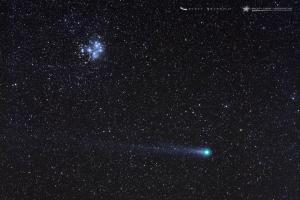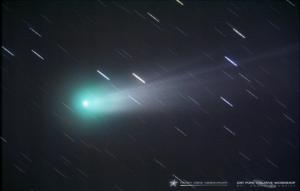
Stargazing Nights
- Where:
- Frosty Drew Observatory
- When:
- Friday December 30, 2016 at 6:00 p.m.
- Cost:
- $1 Suggested Donation per Person
Tonight is Stargazing Night at Frosty Drew Observatory and forecast are looking quite amazing. We can largely expect mostly clear to clear skies all night long. We do see a bit of variability in the amount of clouds that may pass through tonight, though overall, skies look fabulous. The only solid downer tonight is the wind, which may bring gusts into the 28 mph range and can restrict our viewing to one half of the sky – we’ll deal. We also have a beautiful dark night awaiting us being that the super thin 2% waxing crescent Moon will set at 6:00 p.m., leaving amazingly dark skies in its wake. Add in a potential view of Comet 45P early in the night and tonight could be a night to remember!
We will open the Observatory and Sky Theatre at 6:00 p.m. In the Observatory we will start off our night with attempts at viewing Comet 45P/Honda-Mrkos-Pajdusakova, which will sit low on the WSW horizon. After which our telescopes will rock the night with Venus, Uranus, the Orion Nebula, binary stars, star clusters, and anything else that we can geek out with. Remember, dark skies = amazing things. With temps dropping into the high 20’s overnight mixed with wind, it can get quite cold. Well fret not, in the Sky Theatre temps will be toasty warm and on display will be our popular showcase of celestial objects photographed at Frosty Drew Observatory. We will stay open until 11:30 p.m. at the earliest, with the potential for a much later night. Following Frosty Drew Observatory on Twitter (@FrostyDrewOBSY) or Facebook will get you updates from the Observatory, including a “Closing Up” post when we decide to pack it up for the night.
Overall, tonight looks fabulous! We will certainly see some wind and may see a few passing clouds, though if the weather brings its A game, which it often does with variable forecasts, we are set up for a great send off of a rather disappointing year. Wind chills will be the real deal tonight! Dressing properly will totally make the difference between a true geek out moment or a cold bad decision. We wrote an article on how to dress for the cold at Frosty Drew Observatory and we suggest you get cozy with it. Now bundle up, grab a friend or two, and head out to Frosty Drew tonight and meet that inner-geek waiting to break free!
-----------------------
Weekly Happenings
Scott MacNeill
Have you heard the recent buzz about the “New Year’s Eve Comet” in the media? Maybe a friend or family member told you about a blazing bright comet that will light up the sky beside the Moon on New Year’s Eve? Well the comet is Comet 45P/Honda-Mrkos-Pajdusakova (Comet 45P) and it will be 3° to the left of the Moon on New Year’s Eve for sure. Though contrary to much hearsay, it will not be visible to the naked eye. To catch a view, binoculars and/or a telescope will be required, but this is not a reason to skip out on a view or to back off the hype. Comet 45P has formed a beautifully long tail, as seen in recent photographs, and could become a fabulous comet in February 2017!
Comet 45P was discovered on December 3rd, 1948 and is a periodic comet that completes one full orbit around the Sun every 5.25 years. The solid center of the comet, called the nucleus, is only about 1 mile in diameter, though the atmosphere that forms around the nucleus due to vaporizing of gasses as the comet approaches the Sun, called a coma, can grow humongous. 45P will reach perihelion, its closest point to the Sun, on December 31, 2016 for its current orbital period. After which, 45P will begin its journey away from the Sun, bringing a close encounter to Earth on February 11, 2017 when the comet swings passed Earth at a mere 0.09AU (8,366,023 miles) distant.
Viewing Comet 45P will be easy, if you know when and where to look. Contrary to popular banter, 45P will probably not become naked eye visible, unless an unexpected outburst occurs. The next couple nights will bring the potential to catch a binocular or telescopic view of the comet very low in the western sky around 6:00 p.m. The problem is that the comet is so close to the Sun that it drops below the horizon shortly after sunset, right at the end of twilight, and the brighter twilight sky will make the comet dimmer to our view and more difficult to see. The best viewing opportunities will actually happen during the second week of February in the early morning hours before sunrise. Though the comet will rock for a couple weeks in February, the bright Moon will accompany it from February 9th through February 16th. After which, the comet will move back into the evening sky. This leaves us with best viewing dates of February 6th - 8th at 5:00 a.m., with best photography dates continueing further into February after the Moon departs on February 16th.
Over the past few years, we have grown quite accustomed to a binocular or dim-naked-eye visible comet blazing our Holiday and winter time skies. It appears that Comet 45P will be our winter comet of 2017. Any comet that can be seen with binoculars is a comet to get excited about, though don’t expect to see a comet blazing across the sky on New Year’s Eve, and please do not mistaken Venus, which is extremely bright in the southwest sky this winter, as the comet. Best viewing will surely be in February, with an extended period of photo ops, but timing with the bright Moon will make for a short window of viewing opportunities. Regardless, welcome in the New Year and celebrate the winter with the night sky and maybe catch a view of Comet 45P/ Honda-Mrkos-Pajdusakova.
This coming week, one of the best, though lesser known, meteor showers of the year is happening. During the early morning hours of either January 3rd or 4th, the peak of the annual Quadrantid Meteor Shower will occur. Sporting a very brief peak period of only a few hours, the Quadrantids can push meteor rates into the 100 meteors per hour range. Though being such a short peak period, the likelihood of the peak period happening during our daylight hours becomes too problematic to overlook. Though difficult to predict the peak hours precisely, reports are coming in that it may happen around 10:00 a.m. EST on January 3rd. That puts our best viewing period for Southern New England from 3:00 a.m. - sunrise this coming Tuesday, January 3rd. Since the 30% waxing crescent Moon will set early the night before, dark skies will abound to your meteor watching delight. All we need now is for clouds to stay away, which is not looking too promising at this point. If skies are clear enough, we will be at Frosty Drew Observatory that morning to catch the shower. If you’re up to it, stop in and freeze with us or just step outside, lay on your back with your feet to the northeast and watch meteors blaze the sky. If you catch a photo of a Quadrantid meteor, post it on our Facebook and we’ll share it on our timeline. Happy meteor watching!
-Scott



